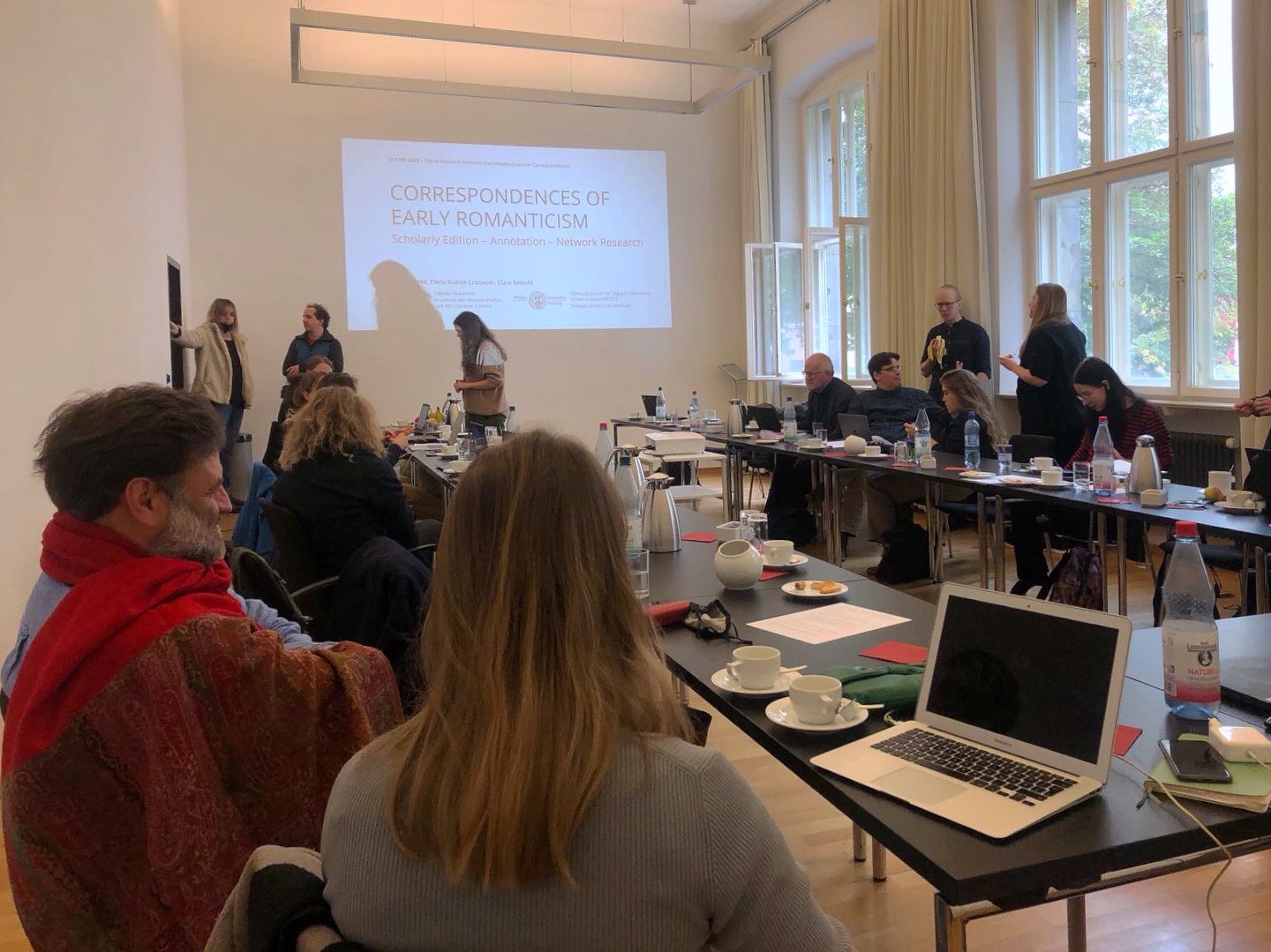… then we take Berlin
On October 4th and 5th in 2022 we participated a workshop in Berlin. The Workshop for Digital Research Methods and Infrastructure for Correspondences was organized by Stefan Dumont and Ilona Pikkanen. The two-day venue took place at Berlin-Brandenburg Academy of Sciences and Humanities (BBAW) downtown Berlin. Our participants from the CoCo team were Prof. Eero Hyvönen, Dr. Mikko Koho, Dr. Senka Drobac, Heikki Rantala, and Petri Leskinen as well as Dr. Ilona Pikkanen, Dr. Hanna-Leena Paloposki and Iida Jauhiainen.

The programme on the first day, Tuesday 4th October, started with an welcoming speech and workshop introduction by Stefan Dumont (BBAW). After that Stefan introduced the correspSearch project and its principles. It is a community-based project to collect epistolary data and aggregate it from multiple data providers. The data model covers the basic needs for modeling epistolary information and it is based on the Correspondence Metadata Interchange Format (CMIF) format. Secondly, the usage of correspSearch web portal was introduced by Ruth Sander (BBAW). Thirdly, some future directions were given like augmenting the schema to facilitate adding more detailed information and publishing the data in a SPARQL endpoint. Some of us were already familiar with the correspSearch project since their data was used as a part in the LetterSampo data publication.
The general discussion after the presentation focused on, e.g., handling missing information in data modeling, which of course is one elementary research question not only for correspSearch or CoCo but more generally for all epistolary databases. There are always gaps in the source data, the correspondents might remain unknown or we may not know the exact places of sending or receiving the letters.
In the second presentation, the project NorKorr – Norwegian Correspondences was introduced by Annika Rockenberger and Loke Sjølie. The project started in 2018 at the National Library Of Norway and in 2019 moved to the University of Oslo Library. In the project letters by Edvard Munch are used as a Pilot Study and there is an openly available eMunch portal as well as the data transformation codes in a GitHub repository. One question that was raised in the following discussion was the possibilities of finding connections between Norway and Finland in the letter data. One possible link could be the letters of Swedish priest Lars Levi Læstadius that were among the source collections. Læstadius was the founder of a religious movement that has rooted also in Northern Finland, and, as a remark, his successor Johan Raattamaa is among the people in CoCo data.
The second part of the programme on the first day was entirely dedicated to our CoCo project! Our presentations followed the same outline as in the Huygens Institute Visit in Amsterdam three weeks ago (in the previous blog post). First presentation was held by Ilona and Hanna-Leena concentrating on general introduction of our consortium project, data gathering from cultural heritage foundations, and humanistic research questions. Second presentation held by Mikko, Senka, and Heikki, discussed the integration, modeling, harmonization, and enriching of epistolary collections and the general problems involved in it. The third and last was my presentation where I showed examples of data queries, visualization, and data analysis made either in the portal or in a programming environment.
After the first day program many of us had dinner and continued the discussions in a nearby Thu My Marie Concept Restaurant.
The program on the second day, 5th October, was started by Malte Vogl and Bernardo Buarque from the Max Planck Institute for the History of Science. They introduced the ModelSEN research project for modeling historical knowledge processes. Their initial case-study was the history of general relativity analyzed by networks built on social relations and citations. The goals of ModelSEN are 1) developing methods for historical network research, 2) studying approaches to design and use ontologies, and 3) collaboration with like-minded partners. The methods for analyzing the multi-layer networks were discussed, the related codes are available in Zenodo. An initial ModelSEN workshop was organized in Berlin last April.
The second presentation was held by Caitlin Burke from the University of Luxembourg. A visualization of the collected letter exchange is provided on the Tudor Networks webpage. In the project the play of power between King Henry VIII and his chief minister Thomas Cromwell was analyzed in detail, such as the effect on the network measures and, e.g., the structure after removing the most central actors.

The workshop’s last presentation was held by Aline Deicke from Academy of Sciences and Literature in Mainz and University of Marburg. Correspondences of Early Romanticism is a project at its early stage. The aim is on recording communication processes and knowledge transfer of the “Romantics” 1790–1802. The focus is on metadata and registers, digital edition of letters from or to August Wilhelm Schlegel being one of the main sources. The letter metadata will be augmented e.g. by using personal relations from the Gemeinsame Normdatei (GND) database and methods of network theory, e.g. triadic closure, will be applied in the project. After the presentation we discussed related themes such as solutions for modeling historical data, ontologies of occupations, and how they model e.g. occupational categories and hierarchies.
The last hour of the workshop was reserved for closing discussion. One topic on that was extending the epistolary data with biographical information. Of course, another topic was about the possibilities for co-operation between the research groups that participated in the workshop.

One thought on “… then we take Berlin”
Comments are closed.